Eyelash
An eyelash (also called lash) (Latin: Cilia) is one of the hairs that grows at the edges of the eyelids. The lashes grow outwards in up to six layers on the edges of the upper and lower eyelids.[1] Eyelashes protect the eye from debris, dust, and small particles and perform some of the same functions as whiskers do on a cat or a mouse in the sense that they are sensitive to being touched, thus providing a warning that an object (such as an insect) is near the eye (which then closes reflexively). The eyelid margin from which lashes grow is among the most sensitive parts of the human body, with many nerve endings enveloping the lashes, giving it sensitivity to light touch,[2] enabling it to trigger the blink reflex when touched.[3]
| Eyelash | |
|---|---|
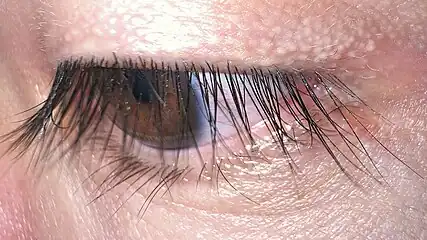 Human eyelashes | |
| Details | |
| System | Sensory |
| Function | Lines the edge of the eyelid, heightening protection of the eye from dust and debris and triggers the blink reflex |
| Identifiers | |
| Latin | cilium |
| Greek | Bλέφαρον (blépharon) |
| MeSH | D005140 |
| TA98 | A15.2.07.037 |
| TA2 | 7057 |
| FMA | 53669 |
| Anatomical terminology | |
Etymology
The word eyelash is a portmanteau derived from the prefix eye- referring to the eye which the lashes surround (by means of growing on the lids) and protects, and the suffix -lash, which can refer to a whip or the act of a stroke with a whip. This is in reference to both the individual lashes resembling a whip, and the action of blinking the eyes causing the lashes to move in a stroking or whipping motion.
Function
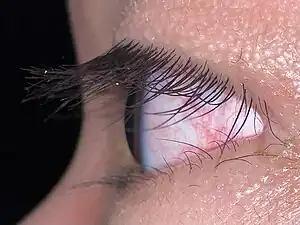
In humans, the eyelashes serve three main functions:
- Protect the eye from dust and debris by catching them before they can enter the eye
- Trigger the blink reflex in the case of a foreign body approaching the eye and touching the lashes
- Regulate or reduce evaporation of the tear film on the cornea[4]
Structure
Development
The eyelashes of the human embryo develop from the ectoderm[5] between the 22nd and 26th week of pregnancy.[6] Eyelashes take about seven to eight weeks to grow back if pulled out, but constant pulling may lead to permanent damage. Their color may differ from that of the hair, although they tend to be dark on someone with dark hair and lighter on someone with light hair. Eyelash hair is not androgenic[7] and is therefore not affected by puberty. Lash follicles do not have an arrector pili muscle associated with them, making the lashes static.[8]
Length and thickness
Human lashes do not vary in length by sex[9] or ethnicity,[10] with the upper lashes of humans typically 7 to 8 mm in length,[9] and generally do not exceed 10 mm in length.[11] Lower lashes average between 5 and 6 mm in length.[9] Eyelashes are considered to be long when they are 10 mm or greater in length.[12] Human eyelash length, thickness, and darkness decrease significantly with age.[13]
Eyelash length is closely linked to the width of the eye, with the lashes typically growing to one-third the width of the eye as an evolutionary adaptation to reduce tear film evaporation and dust deposition. Lashes longer or shorter than one-third the width of the eye have been shown to have reduced efficacy in serving their function.[4] The typical width of the human eye is 24.2 mm,[14] resulting in the average human eyelash length of 7 to 8 mm. This evolutionary trait is perhaps why lashes in humans rarely grow beyond 10 mm in length.[11]

Lashes grow thick at the roots, and have tapered ends. People of Asian ethnicities have significantly thicker lashes than people of Caucasian ethnicities.[10] However, the number of lashes on the eyelids is fewer in Asians than in Caucasians.[10]
Curvature
Eyelashes grow outwards from both upper and lower eyelids, with varying degrees of curl. People of Caucasian ethnicities have lashes that are more curled than those of Asian ethnicities.[10] However, the degree of curling varies significantly even within a population or ethnicity, where people of Asian ethnicities can also exhibit naturally highly curled lashes.[15]
Density

The number of individual lashes on the upper eyelid is typically 90 to 160, and on the lower eyelid 75 to 80.[2] The number of follicles and hence lashes cannot be increased after birth because all follicles develop during embryogenesis.[8]
Glands
The follicles of eyelashes are associated with a number of glands known as the glands of Zeis and the glands of Moll.
Clinical significance
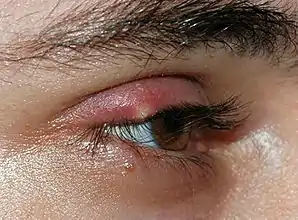
There are a number of diseases or disorders involving the eyelashes:
- Madarosis is the loss of eyelashes.
- Blepharitis is the irritation of the lid margin, where eyelashes join the eyelid. The eyelids are red and itching, the skin often becomes flaky, and the eyelashes may fall out.
- Distichiasis is the abnormal growth of lashes from certain areas of the eyelid.
- Trichiasis refers to ingrown eyelashes.
- Eyelashes may become infested with parasitic crab louse.
- An external hordeolum, or stye, is a purulent inflammation of infected eyelash follicles and surrounding sebaceous (Gland of Zeis) and apocrine (Moll's gland) glands of the lid margin.
- Trichotillomania is a disorder that urges the sufferer to pull out scalp hair, eyelashes, etc.
- Demodex folliculorum (or the demodicid) is a small mite that lives harmlessly in eyelash and other hair follicles, and about 20% of people have these mites living on them.[16] Occasionally they may cause blepharitis.
- People with vernal keratoconjunctivitis have longer eyelashes,[17] with the increased growth likely a result of the occular inflammation accompanying the condition.
- Trichomegaly is the condition of abnormally long and/or lush lashes (the objective criteria being lashes of 12 mm or greater in length on the upper eyelids).[18]
Eyelash transplant surgeries may help to reconstruct lost or damaged lashes. The procedure may also be employed to increase the number of lash follicles on the eyelid to enhance the prominence and fullness of the lashes. The transplanted hairs usually do not have the tapered structure of real lashes, and continue to grow at the same rate as hairs from the area the follicle was extracted from. As such, they require maintenance by means of trimming.
Society and culture
_represents_as_well_as_means_%22eyelash%22.jpg.webp) Ancient Meitei character "PAA" (ꯄ) represents as well as means "eyelash" |
.svg.png.webp) Smaller "PAA", known as "PAA LONSUM" |
The traditional Meitei writing system has two letters (symbols), related to eyelashes. The letter "ꯄ" ("Paa") symbolises the human eyelash, and its letter name "Paa" itself means "eyelash" in Meitei language. It has an additional form of letter, known as "Pa Lonsum" ("ꯞ").[19][20][21]
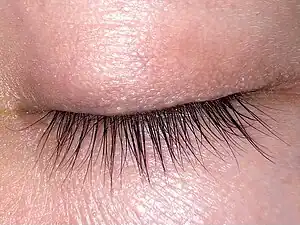
Long and full eyelashes have long been considered a sign of beauty in many cultures.[22] Despite not varying by sex and not being a secondary sex characteristic, long lashes are frequently considered a feminine trait, with studies showing that women possessing longer lashes are perceived as healthier and more feminine.[23] Nevertheless, long lashes are regarded as an attractive facial feature in both males and females.[24] On the other hand, Hadza women are known to trim their own eyelashes.[25]
Because of the role long lashes play in contributing to overall facial attractiveness, they are a prized and desired trait. A study found that a group of Japanese women in their 20s and 30s desired upper eyelashes as long as 14.1 mm, a length outside the range of typical human lash lengths and over twice longer than the average length of 6.8 mm of the same population.[26]
Ancient Romans considered long eyelashes a component of aesthetically ideal eyes. Pliny the Elder wrote that eyelashes fell out from sexual excess, so women desired long lashes as a symbol of chastity.[27] This may have had medical basis as a symptom of syphilis is often alopecia of the lashes,[28] suggesting that individuals with short or sparse lashes were sexually promiscuous.
Nonverbal communication
The lashes and lids play a role in eye contact and nonverbal communication. Voluntarily blinking slowly or a few times in succession quickly is a feminine flirtatious behaviour commonly referred to as to "bat an eyelash", "bat/batting eyelashes", or "flutter/fluttering eyelashes".
Cosmetics

Because long eyelashes are aesthetically pleasing and seen as a desirable trait that adds to physical attractiveness, some people seek to enhance their eyelash length artificially, by means of eyelash extensions, false lashes attached to the eyelid, cosmetics, or growth products. Additionally, eyelashes which are curled are also more prominent, being able to better display their length especially when viewed from the front. The enhanced appearance of curled eyelashes can be cosmetically achieved by use of eyelash curlers, or eyelash perms. However, these methods do not physically lengthen the lashes.
Kohl, a black putty (usually antimony sulfide or lead sulfide), has been worn as far back as the Bronze Age to darken the edge of the eyelid (just at the bottom of the eyelashes). In Ancient Egypt, it was used as well by the wealthy and the royal to beautify their eyes. Modern eye makeup includes mascara, eyeliner, eye putty, and eye shadow to emphasize the eyes. The twentieth century saw the beginning of convincing false eyelashes, popular in the 1960s.
Permanent eyelash tints and eyelash extensions have also become popular procedures, even in fairly basic salons. It is also possible to get eyelash transplants, which are similar in nature to hair transplantation often done on the head. Since the hair is transplanted from the hair on the head, the new eyelashes will continue to grow like head hair and will need to be trimmed regularly.[29]
Latisse was introduced in the first quarter of 2009 by Allergan as the first drug to receive FDA approval for eyelash growth. Latisse is a solution of bimatoprost, a prostaglandin analog and the active component of the glaucoma medication Lumigan. According to Allergan, noticeable eyelash growth occurs within 16 weeks. Growth is reported to occur primarily on the upper eyelashes, with as much as a 25% increase in length.[30] In addition, the past decade has seen the rapid increase in the development of eyelash conditioners. These conditioners are designed to increase the health and length of lashes. Many utilize seed extract, minerals, and other chemicals to achieve these results.[31]
Cosmetic companies have recently relied on scientific research of prostaglandins and the Wnt/b-catenin signaling pathways to develop eyelash products. Although bimatoprost is effective in promoting increased growth of healthy eyelashes and adnexal hairs, its effectiveness in patients with eyelash alopecia areata is debatable.[32] Some cosmetic brands have begun using peptides in their formulation rather than prostaglandins because of regulatory rules in places like Canada and California.[33]
In other animals
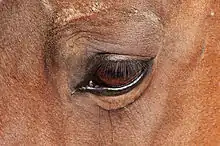
Lashes, being hair, are found in mammals. Camels' lashes are remarkably long and thick. Horses and cows feature eyelashes as well. Inherited eyelash problems are common in some breeds of dogs as well as horses.
Eyelashes are an uncommon but not unknown feature in birds. Hornbills have prominent eyelashes (vestigial feathers with no barbs), as do ostriches. Amongst the reptiles, only Eyelash vipers show a set of modified scales over the eyes which look much like eyelashes.
See also
- Eyelash extensions, used to enhance the appearance of length, curliness, fullness, and thickness of natural eyelashes
- Eyebrows, an area of short hairs above the eyes on the brow ridges
References
- Aumond, Sarah; Bitton, Etty (2018). "The eyelash follicle features and anomalies: A review". Journal of Optometry. 11 (4): 211–222. doi:10.1016/j.optom.2018.05.003. ISSN 1989-1342. PMC 6147748. PMID 30017866.
- Patel, Bhupendra C.; Lopez, Michael J.; Joos, Zachary P. (2023), "Anatomy, Head and Neck: Eyelash", StatPearls, Treasure Island (FL): StatPearls Publishing, PMID 30725963, retrieved 16 May 2023
- Fagien, Steven (13 April 2010). "Management of hypotrichosis of the eyelashes: Focus on bimatoprost". Clinical, Cosmetic and Investigational Dermatology. 3: 39–48. doi:10.2147/CCID.S5488. PMC 3047948. PMID 21437058.
- Amador, Guillermo J.; Mao, Wenbin; DeMercurio, Peter; Montero, Carmen; Clewis, Joel; Alexeev, Alexander; Hu, David L. (April 2015). "Eyelashes divert airflow to protect the eye". Journal of the Royal Society Interface. 12 (105): 20141294. doi:10.1098/rsif.2014.1294. ISSN 1742-5689. PMC 4387520. PMID 25716186.
- Standring, Susan Neil R. Borley (2008). Gray's Anatomy: the Anatomical Basis of Clinical Practice (40th ed.). Edinburgh: Churchill Livingstone/Elsevier. p. 703. ISBN 978-0443066849.
- "Fetal development: MedlinePlus Medical Encyclopedia". Nlm.nih.gov. Retrieved 16 March 2013.
- Randall, VA; Hibberts, NA; Thornton, MJ; Hamada, K; Merrick, AE; Kato, S; Jenner, TJ; De Oliveira, I; Messenger, AG (2000). "The hair follicle: a paradoxical androgen target organ". Horm. Res. 54 (5–6): 243–50. doi:10.1159/000053266. PMID 11595812. S2CID 42826314.
- Fagien, Steven (13 April 2010). "Management of hypotrichosis of the eyelashes: Focus on bimatoprost". Clinical, Cosmetic and Investigational Dermatology. 3: 39–48. doi:10.2147/CCID.S5488. PMC 3047948. PMID 21437058.
- "A study of normal eyelashes in Japanese individuals". www.oatext.com. Retrieved 16 May 2023.
- Na, J.I.; Kwon, O.S.; Kim, B.J.; Park, W.S.; Oh, J.K.; Kim, K.H.; Cho, K.H.; Eun, H.C. (30 August 2006). "Ethnic characteristics of eyelashes: a comparative analysis in Asian and Caucasian females". British Journal of Dermatology. 155 (6): 1170–1176. doi:10.1111/j.1365-2133.2006.07495.x. ISSN 0007-0963. PMID 17107385. S2CID 26752340.
- Thibaut, S.; De Becker, E.; Caisey, L.; Baras, D.; Karatas, S.; Jammayrac, O.; Pisella, P.J.; Bernard, B.A. (1 September 2009). "Human eyelash characterization". British Journal of Dermatology. 162 (2): 304–310. doi:10.1111/j.1365-2133.2009.09487.x. ISSN 0007-0963. PMID 19804590. S2CID 40635760.
- "Eyelashes, Long". elementsofmorphology.nih.gov. Retrieved 16 May 2023.
- Glaser, Dee A.; Jones, Derek; Carruthers, Jean; Campo, Antoinette; Moench, Susan; Tardie, Greg; Largent, Joan; Caulkins, Carrie (November 2014). "Epidemiologic Analysis of Change in Eyelash Characteristics With Increasing Age in a Population of Healthy Women". Dermatologic Surgery. 40 (11): 1208–1213. doi:10.1097/DSS.0000000000000170. ISSN 1076-0512. PMID 25347452. S2CID 24703542.
- Bekerman, Inessa; Gottlieb, Paul; Vaiman, Michael (2014). "Variations in Eyeball Diameters of the Healthy Adults". Journal of Ophthalmology. 2014: 503645. doi:10.1155/2014/503645. ISSN 2090-004X. PMC 4238270. PMID 25431659.
- Kwak, Taek-jong; Lee, Sang-min; Cho, Wan-gu (August 2002). "The character of eyelashes and the choice of mascara in Korean women: The choice of mascara in Korean women". Skin Research and Technology. 8 (3): 155–163. doi:10.1034/j.1600-0846.2002.20352.x. PMID 12236884. S2CID 25356581.
- "A survey on prevalence of demodex infection in vocational college students in fuyang city" (PDF). 中华全科医学.
- Pucci, Neri; Novembre, Elio; Lombardi, Enrico; Massai, Cristina; Bernardini, Roberto; Caputo, Roberto; Campa, Luciana; Libero, Cinzia de; Vierucci, Alberto (2005). "Long Eyelashes in a Case Series of 93 Children With Vernal Keratoconjunctivitis". Pediatrics. 115 (1): e86–e91. doi:10.1542/peds.2004-1555. PMID 15629970. S2CID 10050289. Retrieved 16 May 2023.
- Paul, Laura J.; Cohen, Philip R.; Kurzrock, Razelle (June 2012). "Eyelash trichomegaly: review of congenital, acquired, and drug-associated etiologies for elongation of the eyelashes: Eyelash trichomegaly". International Journal of Dermatology. 51 (6): 631–646. doi:10.1111/j.1365-4632.2011.05315.x. PMID 22607279. S2CID 205398795.
- Ghai, Deepika; Tripathi, Suman Lata; Saxena, Sobhit; Chanda, Manash; Alazab, Mamoun (18 November 2022). Machine Learning Algorithms for Signal and Image Processing. John Wiley & Sons. p. 130. ISBN 978-1-119-86184-3.
- Arambarn Parratt, Saroj Nalini, ed. (2009), "Meetei Mayek or Meetei script chart", The Court Chronicle of the Kings of Manipur, Foundation Books, pp. 145–148, ISBN 978-81-7596-854-7, retrieved 16 October 2023
- "Meetei Mayek: The Script". tabish.freeshell.org. Retrieved 16 October 2023.
- Aguinaldo, Erick; Mousavi, Maedeh; Peissig, Jessie (1 September 2018). "Eyelashes and Attraction: Eyelash Length and Fullness are Significantly Correlated with Facial Attractiveness". Journal of Vision. 18 (10): 1338. doi:10.1167/18.10.1338. ISSN 1534-7362. S2CID 149895886.
- Adam, Aimee (October 2021). "Beauty is in the eye of the beautiful: Enhanced eyelashes increase perceived health and attractiveness". Evolutionary Behavioral Sciences. 15 (4): 356–367. doi:10.1037/ebs0000192. ISSN 2330-2933. S2CID 214292834.
- Pazhoohi, Farid; Kingstone, Alan (April 2022). "The effect of eyelash length on attractiveness: A previously uninvestigated indicator of beauty". Evolutionary Behavioral Sciences. 16 (2): 176–180. doi:10.1037/ebs0000243. ISSN 2330-2933. S2CID 228846079.
- "Hadza". Encyclopedia of Sex and Gender: Men and Women in the World's Cultures, Vol. 1. New York: Springer. 2003. ISBN 978-0-306-47770-6.
- Shiseido Company, Limited (June 2014). "理想の「まつ毛」でまなざしビューティー!" (PDF).
- Pliny the Elder, Natural History, 11.154.
- Chapel, Thomas A. (1980). "The Signs and Symptoms of Secondary Syphilis". Sexually Transmitted Diseases. 7 (4): 161–164. doi:10.1097/00007435-198010000-00002. ISSN 0148-5717. JSTOR 44965786. PMID 7455863. S2CID 34851892.
- "Plug and sew eyelashes for women". Xinhua News. 25 October 2006. Archived from the original on 18 February 2014. Retrieved 16 March 2013.
- Law, Simon K. (21 April 2010). "Bimatoprost in the treatment of eyelash hypotrichosis". Clinical Ophthalmology. 4: 349–358. doi:10.2147/OPTH.S6480. PMC 2861943. PMID 20463804.
- Alonso, M. R.; Damonte, S. P.; Anesini, C. (2019). "Jarilla–Coffea extract: a natural cosmetic product that improves eyelash and eyebrow growth in women". Clinical, Cosmetic and Investigational Dermatology. 12: 47–55. doi:10.2147/CCID.S182497. PMC 6330964. PMID 30666142.
- Law, SK (26 April 2010). "Bimatoprost in the treatment of eyelash hypotrichosis". Clin Ophthalmol. 4: 349–58. doi:10.2147/opth.s6480. PMC 2861943. PMID 20463804.
- "What is an eyelash serum?". LashLuxury. 30 April 2021. Retrieved 10 June 2021.
External links
 Media related to Eyelashes at Wikimedia Commons
Media related to Eyelashes at Wikimedia Commons